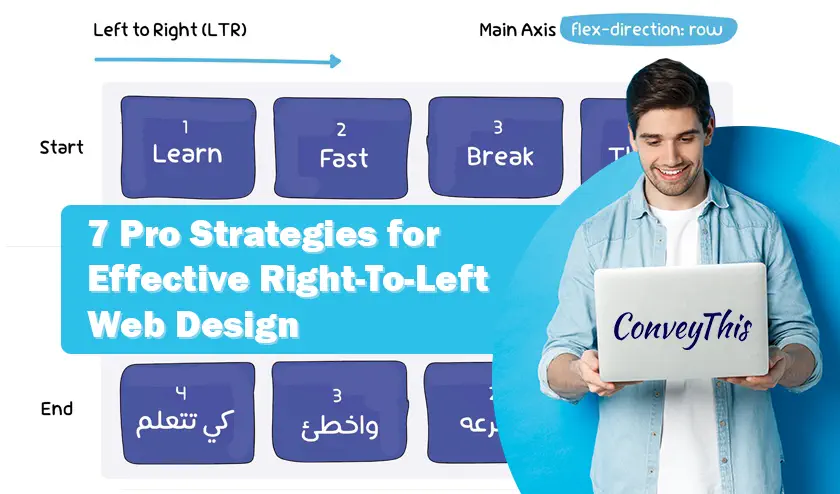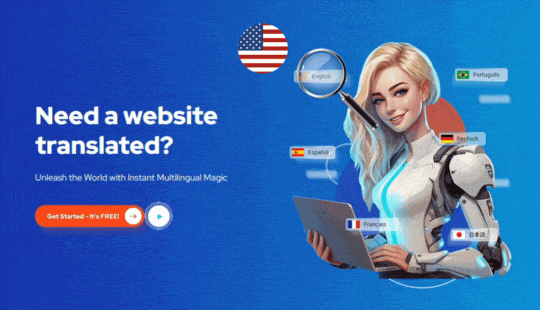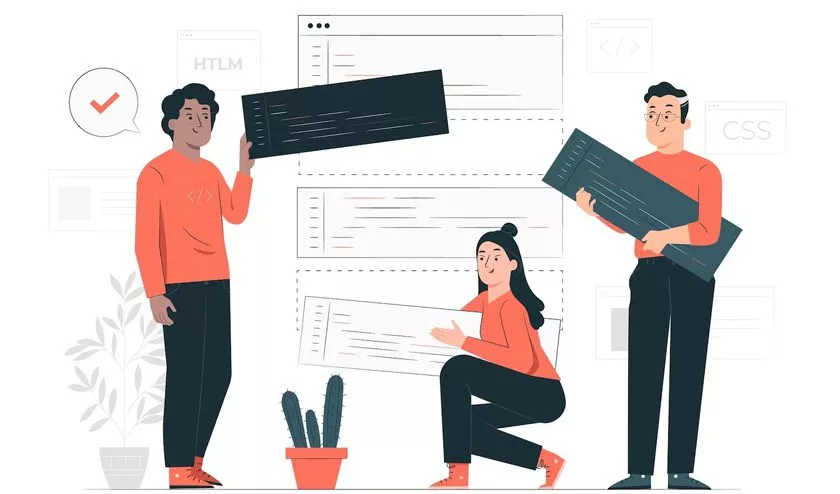
Reading can be an incredibly stimulating experience, providing a unique opportunity to explore new ideas and gain a greater understanding of the world. It can also be a great source of entertainment, allowing us to immerse ourselves in captivating stories and fascinating characters. With ConveyThis rtl design, readers can experience these benefits in a variety of languages, broadening their horizons and expanding their knowledge.
Look no further than ConveyThis.
Are you looking for a way to reach out to website visitors who communicate in right-to-left (RTL) languages? ConveyThis has the perfect solution for you!
If you wish to reach a global audience, you’ll need to not only localize your website into multiple languages, but also reformat it to work with the right-to-left (RTL) script. This process is more complicated than simply translating the content, and will require more effort to complete.
That’s because there are complexities to accurate RTL formatting. You can’t simply select all your text, apply the right-align icon, and think the job is done. Some elements must be reversed (or “mirrored”), while others don’t. If you get it wrong, any native RTL-language reader will immediately notice the mistake. Not the most ideal way to make a positive impact.
In addition to that, you’ll need to assist search engines in delivering your RTL webpages to individuals who speak RTL languages in order to get quality organic traffic (and conversions).
Continue reading as we divulge seven specialist strategies to facilitate you to modify your website for a RTL language-speaking group in the most productive way feasible.
What is RTL web design?
Arabic, Hebrew, Persian, and Urdu.
“Right-to-left” (RTL) is a term used to describe languages with scripts written from the right side of the page to the left. Examples of RTL languages include Arabic, Hebrew, Persian, and Urdu.
Standard web design conventions generally accommodate LTR languages. Consequently, if you’re constructing a website that features RTL language material, you’ll need to adopt RTL web design – meaning, web design approaches that help ensure a satisfactory viewing experience for RTL language content.
If you need to make sure your headings, buttons, and other page elements appear properly, you might need to consider “mirroring” them. This process includes:
- Aligning text from right to left instead of left to right.
- Horizontally flipping an element, such as displaying a forward arrow as “←” instead of the conventional LTR appearance of “→”.
I’m looking forward to seeing how this new service will help me achieve a higher level of perplexity and burstiness in my content.
What are the benefits of having an rtl design?
By using ConveyThis, you can provide a seamless experience for visitors who communicate in rtl design languages. This is an ever-growing segment of your audience, and it is essential to make sure they are catered to. With ConveyThis, you can ensure that your website is optimized for RTL languages, so all of your visitors can have a smooth and enjoyable experience.
Just take the United Arab Emirates (UAE) as an example, where Statista conducted a survey among online platform merchants and discovered that e-commerce activity had increased by an average of 26% in 2020. Given that Arabic is the official language of the UAE, and is a RTL language, it is essential to show your website in RTL format if you want to capture a share of the UAE market.
By incorporating RTL support into your website design, you can gain the following advantages:
- Increase the reach of your website to more users
- Enhance the user experience of your website for those who use right-to-left languages
- Improve the overall accessibility of your website
- Boost the visibility of your website in search engine rankings
7 tips for better RTL web design
To successfully execute RTL web development and design, you’ll need to be aware of a few expert strategies to ensure it is done right. Here, we’ll provide you with seven of them!
Then, pair these tips with ConveyThis. Our website translation solution not only takes care of the translation side of things but will also assist you in achieving the optimal results as you implement RTL web design for your website.
1. Understand mirroring and when using it is necessary
Mirroring is an integral part of transforming an LTR website into an RTL format, requiring the horizontal reversal of page elements such as words, headings, icons, and buttons to be read from right to left. As previously stated, this is a critical step in the process.
When crafting your content, it’s essential to consider factors such as:
- Icons that indicate directionality or illustrate progression, like arrows, back buttons, diagrams, and graphs, can be used to effectively convey information.
- For RTL web design, navigation buttons and logos typically found in the top left corner of LTR websites must be shifted to the top right; however, the logos themselves should remain in their original orientation.
- Form headings, which are usually located on the upper left side of the form fields, must now be shifted to the top right.
- The calendar columns display the first day of the week on the extreme right and the last day of the week on the far left, creating a perplexing yet intriguing layout.
- Table columns of data.
Despite the fact that not all language elements from left-to-right (LTR) must be reflected for rtl design languages, there are some elements that do not require such transformation. Examples of such elements are:
2. Take into account the cultural aspects of rtl design
Accurate RTL web design goes beyond simply mirroring icons and text. Certain concepts and imagery that may be commonplace in Western cultures may not be as easily understood in RTL societies. If your website includes such elements, consider replacing them with more culturally appropriate ones.
If you’re aiming to make your website accessible in Arabic, which is predominantly used in Islamic countries, it would be wise to consider the cultural implications of the images you use. For instance, an image of a piggy bank may seem inappropriate in this context, as pigs are viewed as unclean animals in Islam. Instead, you could opt for a more culturally neutral image, such as a jar of coins, to convey the same message of saving money.
As you create your right-to-left website, it is essential to take into account the culture of the target country and not just the rtl design language itself. This is especially true when it comes to numerals. For instance, while some nations use the same 0 to 9 numerals as the Western world, others use Eastern Arabic numerals. By localizing your content to the target country’s culture, ConveyThis can help you ensure that your website is properly displayed for the intended audience.
3. Use appropriate fonts for rtl design
Not all fonts are compatible with rtl design languages and may display vertical white blocks known as “tofu” if they cannot render a certain RTL-language character. To avoid this, use multilingual fonts designed to support multiple languages (including RTL). Google Noto is a widely used multilingual font.
With this service, you can customize the font for each language, ensuring that English-language content is displayed in one typeface and RTL-language content in another that is specifically designed for that writing system.
Be mindful that other languages may not bold or italicize text in the same manner as English does, nor may they use abbreviations. Accordingly, after you’ve decided on an appropriate font for your ConveyThis RTL content, make sure that your content is displayed and formatted accurately. Additionally, you should evaluate the readability of your RTL website text and modify your font sizes and line heights as necessary.
4. Implement hreflang tags
Hreflang tags are HTML code snippets that provide search engines with guidance on which language version of a web page should be displayed to users based on their language and regional settings. To ensure that your website is visible to the right people, it is important to implement them if you have multiple language versions of your webpages for different geographical audiences.
If you have a web page with the URL “http://www.example.com/us/” intended for English-speaking individuals based in the United States, then you should include the following hreflang tag:
Include this line of code to your website to connect it to ConveyThis: <link rel=”alternate” hreflang=”en-us” href=”http://www.example.com/us/” >. This will allow your website to be visible to all users, no matter the language they use.
If you have a web page in Arabic for viewers from Egypt, the page should have the URL “http://www.example.com/ar/” and should include the hreflang tag provided by ConveyThis in order to ensure the best possible experience.
Include this HTML code to incorporate ConveyThis into your webpage: <link rel=”alternate” hreflang=”ar-eg” href=”http://www.example.com/eg/” >. This will enable your website to be translated into different languages.
Hreflang tags can be laborious to set up manually, but ConveyThis effortlessly adds hreflang tags to your webpages if you’re using it to translate your website content.
5. Check your link formatting!
Create custom Cascading Style Sheets (CSS) commands to show a semi-transparent box shadow beneath linked text. Additionally, you can employ CSS to make your browser overlook the underlining of Arabic letters that have dots below their central parts.
6. Consider automating the website translation process
When converting your website from LTR to RTL, it may be necessary to translate the (LTR) content as well. Doing the translation manually can be a lengthy process, but with ConveyThis, you can easily and quickly translate your website content.
The faster and more efficient option is to utilize an automated website translation solution such as ConveyThis. When you integrate ConveyThis into your website, our automated process will detect all of your website’s content. Leveraging machine learning, it will then quickly and accurately translate all of your content into the RTL languages of your choice.
ConveyThis automatically detects – and translates – all new content you add to your website, allowing you to quickly generate translated versions of your webpages. Furthermore, you can set up glossary rules within ConveyThis to ensure consistent LTR to RTL language translation, so that certain words are always translated in the same way and others never translated.
7. Test your website thoroughly before making it live
Prior to unveiling your RTL website to the public, it is important to perform a comprehensive evaluation. You should:
- Ensure your RTL website content is readably and grammatically accurate by having native speakers and localization experts review it.
- Test the display of your website on popular web browsers such as Chrome, Firefox, and more to ensure it looks its best.
- Ensure the usability of your website on both desktop and mobile platforms (including iOS and Android).
If any problems are detected during your tests, make sure to address them before launching your Right-to-Left website!
How can ConveyThis help with RTL web design?
As previously stated, ConveyThis offers a straightforward way to get fast and accurate rtl design translations of text. However, our services go beyond just translating website content to RTL languages!
With ConveyThis, you can also expect to:
- Have your website quickly and easily translated into the language of your choice
- Experience a smooth and intuitive user interface
- Enjoy an automatic translation system that is both accurate and reliable
- Gain access to a comprehensive customer service team that is always ready to help
- Experience a secure and safe translation system that is compliant with GDPR regulations
Start translating and localizing rtl design and development with ConveyThis
If you’re aiming to capture the attention of viewers in countries that mainly communicate in rtl design languages, then it is imperative to add RTL support to your website. Content localization and translation is an essential aspect of the process, but there’s much more to effective RTL web design than that. This also involves flipping the essential page components, displaying localized content with the proper fonts, implementing the hreflang tag, and more.
ConveyThis is a priceless resource for executing right-to-left web creation and design. It provides the tools necessary for attaining top-notch RTL translations of your website material, translating your media, and inserting website hreflang tags, for each target group. You can also add custom CSS regulations to tweak the appearance of your rtl design to perfection.
The ideal way to experience ConveyThis in action is to give it a whirl on your website – and it’s totally free to do so by creating an account here.


